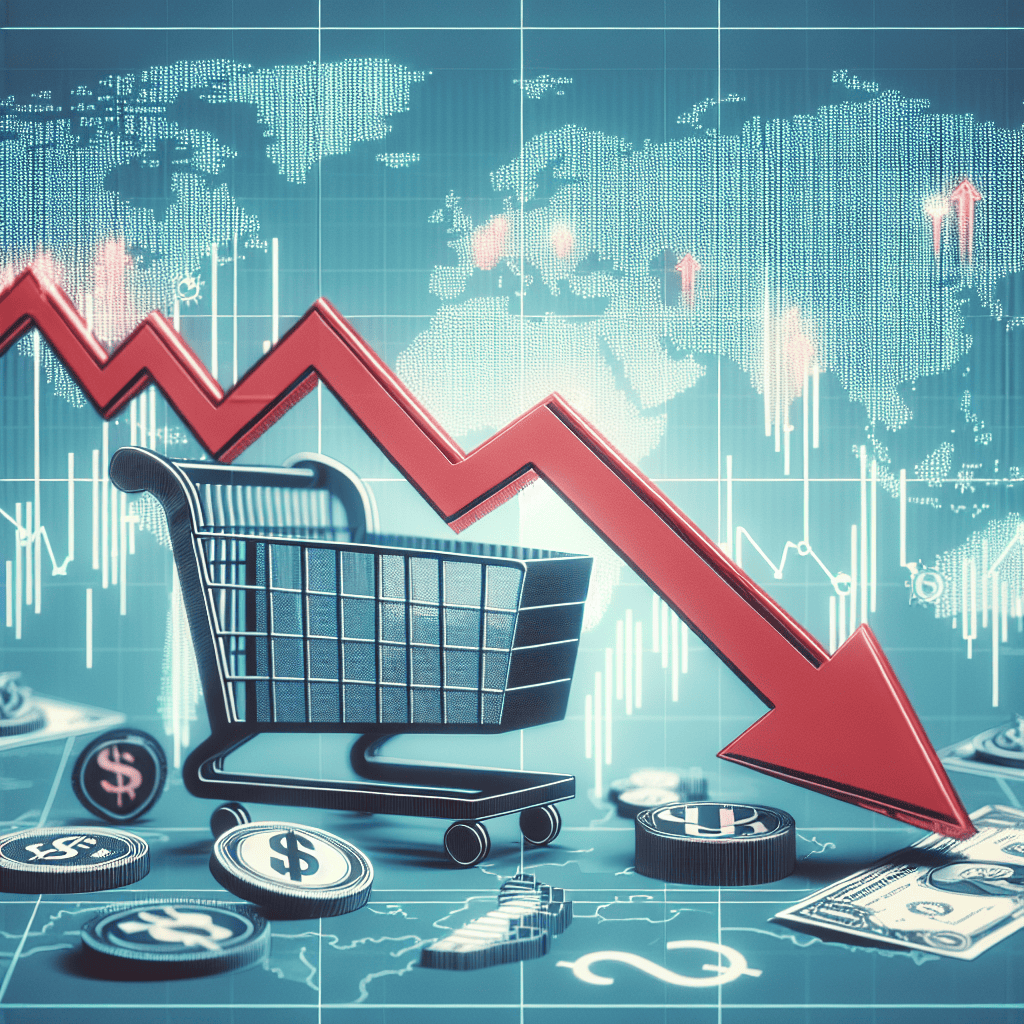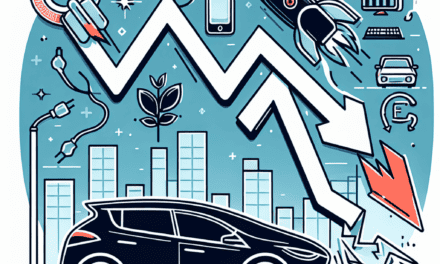“Global Giants Stumble: P&G Faces Headwinds with Sales Dip in Key Markets”
Introduction
Procter & Gamble (P&G), a global leader in consumer goods, recently reported an unexpected decline in quarterly sales, highlighting challenges in key markets such as the United States and China. This downturn is attributed to sluggish consumer demand, which has impacted the company’s performance despite its diverse portfolio of well-known brands. The sales decline raises concerns about broader economic trends and consumer behavior in these significant markets, prompting P&G to reassess its strategies to navigate the evolving landscape. As the company grapples with these challenges, stakeholders are closely monitoring its response to ensure sustained growth and market resilience.
Analyzing P&G’s Sales Decline: Key Factors Behind the Unexpected Drop
Procter & Gamble (P&G), a global leader in consumer goods, recently reported an unexpected decline in quarterly sales, a development that has raised concerns among investors and market analysts. This downturn is particularly noteworthy given the company’s historical resilience and strong market presence. The decline in sales has been attributed to sluggish demand in two of its largest markets, the United States and China, which together account for a significant portion of P&G’s revenue. Understanding the factors behind this unexpected drop requires a closer examination of both macroeconomic conditions and specific challenges faced by the company.
To begin with, the economic landscape in the United States has been marked by a series of challenges that have impacted consumer spending. Inflationary pressures have led to increased prices for everyday goods, which in turn has affected consumer purchasing power. As households adjust their budgets to accommodate higher costs for essentials such as food and energy, discretionary spending on non-essential items, including some of P&G’s product lines, has seen a decline. This shift in consumer behavior has been a critical factor in the reduced demand for P&G’s offerings in the U.S. market.
In addition to domestic economic challenges, P&G has also faced headwinds in China, a market that has been pivotal to its growth strategy. The Chinese economy has been experiencing a slowdown, influenced by a combination of factors including regulatory changes, a cooling real estate market, and ongoing trade tensions. These elements have contributed to a more cautious consumer sentiment, leading to a decrease in spending on consumer goods. For P&G, which has invested heavily in expanding its footprint in China, this slowdown has translated into lower-than-expected sales figures.
Moreover, the competitive landscape in both the U.S. and China has intensified, with local and international brands vying for market share. In response to changing consumer preferences, many companies have been quick to innovate and adapt, offering products that cater to emerging trends such as sustainability and health consciousness. P&G, while a leader in many product categories, faces the challenge of maintaining its competitive edge in an environment where agility and innovation are paramount.
Furthermore, supply chain disruptions have also played a role in P&G’s sales decline. The global supply chain has been under strain due to a variety of factors, including the lingering effects of the COVID-19 pandemic, geopolitical tensions, and logistical bottlenecks. These disruptions have led to increased costs and delays, affecting P&G’s ability to deliver products efficiently and maintain optimal inventory levels. Consequently, the company has had to navigate these challenges while striving to meet consumer demand and uphold its reputation for quality and reliability.
In light of these factors, P&G’s management has acknowledged the need for strategic adjustments to address the current market dynamics. This includes a focus on cost management, enhancing supply chain resilience, and accelerating innovation to meet evolving consumer needs. By leveraging its strong brand portfolio and global reach, P&G aims to navigate these challenges and return to a growth trajectory.
In conclusion, the unexpected decline in P&G’s quarterly sales underscores the complex interplay of economic, competitive, and operational factors that the company must contend with. As P&G works to address these challenges, its ability to adapt and innovate will be crucial in regaining momentum and sustaining its leadership position in the global consumer goods market.
The Impact of Sluggish Demand in the US and China on P&G’s Financial Performance
Procter & Gamble (P&G), a global leader in consumer goods, recently reported an unexpected decline in quarterly sales, attributing this downturn to sluggish demand in two of its most significant markets: the United States and China. This development has raised concerns among investors and analysts, as these markets are crucial to the company’s overall financial performance. The decline in sales highlights the challenges P&G faces in maintaining its growth trajectory amid shifting consumer preferences and economic uncertainties.
In the United States, P&G’s largest market, the company has been grappling with changing consumer behaviors. The pandemic-induced shift towards online shopping and the increasing preference for private-label brands have intensified competition. As consumers become more price-sensitive, they are opting for cheaper alternatives, impacting P&G’s sales of premium products. Furthermore, inflationary pressures have led to higher production costs, forcing the company to raise prices. While price increases have helped offset some of the cost pressures, they have also dampened consumer demand, contributing to the sales decline.
Meanwhile, in China, P&G is facing a different set of challenges. The Chinese economy has been experiencing a slowdown, exacerbated by ongoing trade tensions and regulatory changes. These factors have led to reduced consumer spending, particularly in discretionary categories where P&G has a strong presence. Additionally, the resurgence of COVID-19 cases in certain regions has disrupted supply chains and affected retail operations, further impacting sales. The company’s efforts to expand its market share in China have been hindered by these macroeconomic headwinds, making it difficult to achieve the desired growth.
Despite these challenges, P&G remains committed to its long-term strategy of innovation and brand building. The company is investing in research and development to create new products that cater to evolving consumer needs. By leveraging its strong portfolio of brands, P&G aims to capture market share in emerging categories and drive growth. Moreover, the company is focusing on digital transformation to enhance its e-commerce capabilities and improve customer engagement. These initiatives are expected to strengthen P&G’s competitive position and mitigate the impact of sluggish demand in key markets.
In response to the current market conditions, P&G is also implementing cost-saving measures to improve operational efficiency. The company is optimizing its supply chain and streamlining its operations to reduce expenses. By enhancing productivity and controlling costs, P&G aims to protect its profit margins and maintain financial stability. Additionally, the company is exploring strategic partnerships and acquisitions to diversify its product offerings and expand its global footprint. These efforts are intended to create new growth opportunities and drive long-term value for shareholders.
While the unexpected sales decline poses challenges for P&G, the company remains resilient and focused on navigating the current economic landscape. By adapting to changing market dynamics and leveraging its strengths, P&G is well-positioned to overcome the obstacles it faces. The company’s commitment to innovation, operational excellence, and strategic growth initiatives will be crucial in sustaining its financial performance and delivering value to stakeholders. As P&G continues to address the challenges in the US and China, its ability to adapt and innovate will determine its success in the evolving global marketplace.
How P&G Plans to Address the Challenges of Decreased Consumer Spending
Procter & Gamble (P&G), a global leader in consumer goods, recently reported an unexpected decline in quarterly sales, primarily attributed to sluggish demand in two of its largest markets: the United States and China. This downturn has prompted the company to reassess its strategies and implement measures to address the challenges posed by decreased consumer spending. As P&G navigates this complex landscape, it is essential to understand the multifaceted approach the company is adopting to mitigate the impact of these economic headwinds.
To begin with, P&G is intensifying its focus on innovation and product differentiation. Recognizing that consumers are becoming more discerning with their purchases, the company is investing heavily in research and development to create products that offer unique value propositions. By enhancing product quality and introducing new features, P&G aims to capture the attention of consumers who are increasingly seeking more bang for their buck. This strategy not only helps in retaining existing customers but also attracts new ones who are looking for superior alternatives in a crowded marketplace.
In addition to product innovation, P&G is also revisiting its pricing strategies. The company is exploring a more dynamic pricing model that allows for greater flexibility in response to market conditions. By offering promotions and discounts strategically, P&G hopes to stimulate demand without compromising its brand equity. This approach is particularly crucial in price-sensitive markets where consumers are more likely to switch brands based on cost considerations. Moreover, P&G is leveraging data analytics to gain insights into consumer behavior, enabling the company to tailor its pricing strategies more effectively.
Furthermore, P&G is expanding its digital footprint to enhance consumer engagement and drive sales. With the rise of e-commerce and digital platforms, the company is investing in digital marketing and online sales channels to reach a broader audience. By optimizing its digital presence, P&G can connect with consumers more directly and offer personalized shopping experiences. This digital transformation is not only about increasing sales but also about building stronger relationships with consumers, thereby fostering brand loyalty in the long term.
Another critical aspect of P&G’s strategy is its commitment to sustainability and corporate social responsibility. As consumers become more environmentally conscious, P&G is aligning its operations with sustainable practices to meet the growing demand for eco-friendly products. By reducing its carbon footprint and promoting sustainable sourcing, the company is appealing to a segment of consumers who prioritize environmental considerations in their purchasing decisions. This commitment to sustainability not only enhances P&G’s brand image but also positions it as a leader in responsible business practices.
Lastly, P&G is strengthening its supply chain resilience to ensure consistent product availability. The company is diversifying its supplier base and investing in advanced technologies to streamline its supply chain operations. By doing so, P&G aims to mitigate the risks associated with supply chain disruptions, which have been exacerbated by the ongoing global economic uncertainties. A robust supply chain ensures that P&G can meet consumer demand promptly, thereby maintaining its competitive edge in the market.
In conclusion, P&G’s response to the challenges of decreased consumer spending is a comprehensive strategy that encompasses innovation, pricing, digital engagement, sustainability, and supply chain resilience. By adopting this multifaceted approach, P&G is well-positioned to navigate the current economic landscape and emerge stronger in the face of adversity. As the company continues to adapt to changing consumer preferences and market dynamics, it remains committed to delivering value to its stakeholders and maintaining its leadership position in the global consumer goods industry.
Market Trends: Understanding the Consumer Behavior Shifts Affecting P&G

Procter & Gamble (P&G), a global leader in consumer goods, recently reported an unexpected decline in quarterly sales, a development that has raised eyebrows among market analysts and investors alike. This downturn is primarily attributed to sluggish demand in two of its most significant markets: the United States and China. Understanding the consumer behavior shifts that have led to this decline is crucial for comprehending the broader market trends affecting P&G and similar companies in the consumer goods sector.
To begin with, the economic landscape in the United States has been marked by a degree of uncertainty, which has influenced consumer spending patterns. Inflationary pressures have led to increased prices for everyday goods, prompting consumers to become more price-sensitive and cautious with their expenditures. As a result, many have shifted their purchasing habits, opting for private-label or store-brand products that offer similar quality at a lower cost. This trend has directly impacted P&G, which is known for its premium brands that often come with a higher price tag. Consequently, the company has faced challenges in maintaining its market share as consumers prioritize affordability over brand loyalty.
In addition to economic factors, changing consumer preferences have also played a significant role in the sales decline. There is a growing demand for sustainable and eco-friendly products, a trend that has gained momentum over the past few years. Consumers are increasingly aware of the environmental impact of their purchases and are seeking products that align with their values. While P&G has made strides in this area by introducing more sustainable product lines and committing to environmental goals, the pace of change may not be fast enough to meet consumer expectations. Competitors that have been quicker to adapt to these preferences are capturing a larger share of the market, further contributing to P&G’s sales challenges.
Turning to China, the situation is somewhat different but equally complex. The Chinese market, which has been a significant growth driver for P&G in recent years, is experiencing its own set of challenges. Economic growth in China has slowed, and consumer confidence has been affected by various factors, including geopolitical tensions and domestic policy changes. This has led to a more cautious approach to spending among Chinese consumers, who are now more selective in their purchasing decisions. Additionally, local competitors in China have become more adept at catering to the specific needs and preferences of Chinese consumers, offering products that are not only competitively priced but also culturally resonant. This increased competition has made it more difficult for P&G to maintain its growth trajectory in the region.
In light of these challenges, P&G is likely to reassess its strategies to better align with the evolving market dynamics. This may involve a greater emphasis on innovation, particularly in developing products that meet the demand for sustainability and affordability. Furthermore, enhancing digital engagement and leveraging data analytics to gain deeper insights into consumer behavior could provide P&G with a competitive edge. By understanding and adapting to these consumer behavior shifts, P&G can position itself to navigate the current market landscape more effectively and potentially reverse the trend of declining sales.
In conclusion, the unexpected quarterly sales decline reported by P&G underscores the importance of staying attuned to consumer behavior shifts. As economic conditions and consumer preferences continue to evolve, companies in the consumer goods sector must remain agile and responsive to maintain their market position. For P&G, this means not only addressing immediate challenges but also anticipating future trends to ensure long-term success.
P&G’s Strategic Response to Global Economic Uncertainties
Procter & Gamble (P&G), a global leader in consumer goods, recently reported an unexpected decline in quarterly sales, attributing the downturn to sluggish demand in two of its largest markets, the United States and China. This development has prompted the company to reassess its strategies in response to the prevailing global economic uncertainties. As the economic landscape continues to evolve, P&G is navigating a complex array of challenges, including fluctuating consumer spending patterns and geopolitical tensions, which have collectively contributed to the current sales slump.
In the United States, P&G has observed a noticeable shift in consumer behavior, with many opting for more cost-effective alternatives amid rising inflation and economic uncertainty. This trend has been exacerbated by the lingering effects of the COVID-19 pandemic, which has reshaped consumer priorities and spending habits. As a result, P&G is focusing on enhancing its value proposition by emphasizing product quality and innovation. The company is investing in research and development to introduce new products that cater to the changing needs of consumers, while also reinforcing its commitment to sustainability, a factor increasingly influencing purchasing decisions.
Meanwhile, in China, P&G faces a different set of challenges. The Chinese market, which has been a significant growth driver for the company in recent years, is experiencing a slowdown due to a combination of regulatory changes and economic headwinds. The Chinese government’s stringent regulatory environment, coupled with a deceleration in economic growth, has dampened consumer confidence and spending. In response, P&G is adopting a more localized approach, tailoring its marketing strategies to resonate with Chinese consumers’ preferences and cultural nuances. By leveraging digital platforms and e-commerce channels, P&G aims to strengthen its presence in this critical market and capture the attention of tech-savvy consumers.
Furthermore, P&G is acutely aware of the broader geopolitical tensions that are impacting global trade and supply chains. The ongoing trade disputes and tariff uncertainties have necessitated a reevaluation of the company’s supply chain strategies. To mitigate these risks, P&G is diversifying its supplier base and exploring opportunities to localize production in key markets. This approach not only reduces dependency on any single market but also enhances the company’s resilience against potential disruptions.
In addition to these strategic adjustments, P&G is placing a strong emphasis on cost management and operational efficiency. By streamlining its operations and optimizing its supply chain, the company aims to maintain profitability despite the challenging economic environment. This focus on efficiency is complemented by strategic investments in digital transformation, which are expected to drive long-term growth and enhance customer engagement.
As P&G navigates these global economic uncertainties, the company remains committed to its core values of innovation, quality, and sustainability. By adapting its strategies to address the unique challenges in each market, P&G is positioning itself to emerge stronger and more resilient. While the current sales decline presents a formidable challenge, P&G’s proactive approach and strategic initiatives underscore its determination to maintain its leadership position in the consumer goods industry. As the company continues to adapt to the evolving economic landscape, it remains focused on delivering value to its consumers and stakeholders worldwide.
The Role of Inflation and Supply Chain Issues in P&G’s Sales Decline
Procter & Gamble (P&G), a global leader in consumer goods, recently reported an unexpected decline in quarterly sales, attributing this downturn to sluggish demand in two of its largest markets: the United States and China. This development has raised concerns among investors and analysts, prompting a closer examination of the underlying factors contributing to this decline. Notably, inflation and supply chain issues have emerged as significant challenges that have impacted P&G’s performance during this period.
To begin with, inflation has been a persistent issue affecting various sectors of the global economy, and P&G is no exception. Rising costs of raw materials, transportation, and labor have exerted pressure on the company’s profit margins. As inflation rates continue to climb, P&G has faced the difficult decision of whether to absorb these increased costs or pass them on to consumers through higher prices. In many cases, the company has opted for the latter, which has, in turn, affected consumer purchasing behavior. Higher prices have led to reduced demand for P&G’s products, as consumers become more price-sensitive and seek more affordable alternatives.
Moreover, the impact of inflation is not limited to consumer behavior alone. It also affects the company’s operational efficiency. For instance, increased costs for packaging materials and energy have forced P&G to reevaluate its production processes and supply chain strategies. This reevaluation has sometimes resulted in delays and disruptions, further complicating the company’s ability to meet consumer demand effectively.
In addition to inflationary pressures, supply chain issues have played a crucial role in P&G’s sales decline. The global supply chain has been under significant strain due to a combination of factors, including the COVID-19 pandemic, geopolitical tensions, and natural disasters. These disruptions have led to shortages of essential components and raw materials, causing delays in production and distribution. For P&G, this has meant that certain products have been unavailable or delayed in reaching store shelves, leading to missed sales opportunities.
Furthermore, the supply chain challenges have been particularly pronounced in the United States and China, two key markets for P&G. In the United States, logistical bottlenecks and labor shortages have hindered the company’s ability to maintain a steady flow of goods. Meanwhile, in China, strict COVID-19 lockdowns and regulatory changes have disrupted manufacturing and distribution networks, further exacerbating supply chain issues. These challenges have collectively contributed to the decline in sales, as P&G struggles to keep up with consumer demand in these regions.
Despite these challenges, P&G remains committed to addressing the issues at hand. The company is actively working to mitigate the impact of inflation by exploring cost-saving measures and enhancing operational efficiencies. Additionally, P&G is investing in strengthening its supply chain resilience by diversifying its supplier base and leveraging technology to improve logistics and inventory management.
In conclusion, the unexpected quarterly sales decline reported by P&G underscores the significant role that inflation and supply chain issues have played in shaping the company’s recent performance. As P&G navigates these challenges, it will be crucial for the company to adapt its strategies to the evolving economic landscape. By doing so, P&G aims to restore growth and maintain its position as a leader in the consumer goods industry, even amid the ongoing uncertainties in the global market.
Future Outlook: Can P&G Bounce Back from the Recent Sales Setback?
Procter & Gamble (P&G), a global leader in consumer goods, recently reported an unexpected decline in quarterly sales, raising concerns about its future performance. This downturn, primarily attributed to sluggish demand in the United States and China, has prompted analysts and investors to question whether the company can rebound from this setback. As P&G navigates these challenges, several factors will play a crucial role in determining its ability to regain momentum and sustain growth.
To begin with, understanding the root causes of the sales decline is essential. In the United States, inflationary pressures have led consumers to become more price-sensitive, prompting them to seek out cheaper alternatives or delay non-essential purchases. This shift in consumer behavior has affected P&G’s sales, particularly in categories where competition is fierce. Meanwhile, in China, the economic slowdown and ongoing uncertainties related to the pandemic have dampened consumer spending, further impacting P&G’s performance. These challenges highlight the need for the company to adapt its strategies to better align with evolving market conditions.
In response to these challenges, P&G is likely to focus on several strategic initiatives aimed at revitalizing its sales growth. One potential avenue is product innovation, which has historically been a cornerstone of P&G’s success. By introducing new and improved products that cater to changing consumer preferences, the company can differentiate itself from competitors and capture a larger market share. Additionally, P&G may explore opportunities to expand its presence in emerging markets, where rising incomes and increasing consumer demand present significant growth potential.
Moreover, P&G’s ability to leverage digital transformation will be critical in its efforts to bounce back. The company has already made strides in enhancing its digital capabilities, such as investing in e-commerce platforms and utilizing data analytics to gain insights into consumer behavior. By further strengthening its digital infrastructure, P&G can improve its supply chain efficiency, optimize marketing strategies, and deliver a more personalized shopping experience to consumers. This digital focus not only helps in addressing current challenges but also positions the company for long-term success in an increasingly digital world.
Furthermore, sustainability initiatives are likely to play a pivotal role in P&G’s future strategy. As consumers become more environmentally conscious, there is growing demand for products that are both effective and sustainable. P&G has already committed to several sustainability goals, such as reducing its carbon footprint and increasing the use of recycled materials in its packaging. By continuing to prioritize sustainability, the company can enhance its brand reputation and appeal to a broader consumer base, thereby driving sales growth.
In addition to these strategic initiatives, P&G’s financial resilience will be a key factor in its ability to navigate the current challenges. The company boasts a strong balance sheet and a history of prudent financial management, which provides it with the flexibility to invest in growth opportunities and weather economic uncertainties. This financial strength, coupled with its diverse portfolio of trusted brands, positions P&G well to overcome the recent sales setback.
In conclusion, while P&G faces significant challenges in the wake of its unexpected quarterly sales decline, there are several pathways through which the company can potentially bounce back. By focusing on product innovation, digital transformation, sustainability, and leveraging its financial resilience, P&G can adapt to changing market dynamics and position itself for future growth. As the company implements these strategies, stakeholders will be closely watching to see if P&G can successfully navigate this period of uncertainty and emerge stronger than before.
Q&A
1. **What caused P&G’s unexpected quarterly sales decline?**
Sluggish demand in both the US and China contributed to the decline.
2. **Which markets were primarily responsible for the sales decline?**
The US and China were the primary markets responsible for the decline.
3. **How did the sales decline affect P&G’s financial performance?**
The decline negatively impacted P&G’s quarterly financial performance, leading to lower-than-expected sales figures.
4. **What products or categories were most affected by the sluggish demand?**
Specific product categories were not detailed, but consumer goods typically affected include household and personal care products.
5. **Did P&G provide any guidance or strategy to address the sales decline?**
Companies often respond with strategies to boost demand, such as marketing campaigns or product innovation, though specific strategies were not detailed.
6. **How did the market react to P&G’s sales report?**
The market reaction likely included a drop in P&G’s stock price due to the unexpected sales decline.
7. **What are potential long-term impacts of this sales decline for P&G?**
Potential long-term impacts could include reevaluation of market strategies, adjustments in supply chain management, and increased focus on emerging markets.
Conclusion
Procter & Gamble’s unexpected quarterly sales decline highlights significant challenges in key markets, particularly the United States and China. The sluggish demand in these regions suggests potential shifts in consumer behavior, economic pressures, or increased competition affecting P&G’s market performance. This downturn underscores the need for strategic adjustments to address these market dynamics, possibly through innovation, targeted marketing, or cost management, to regain growth momentum and stabilize future sales.





